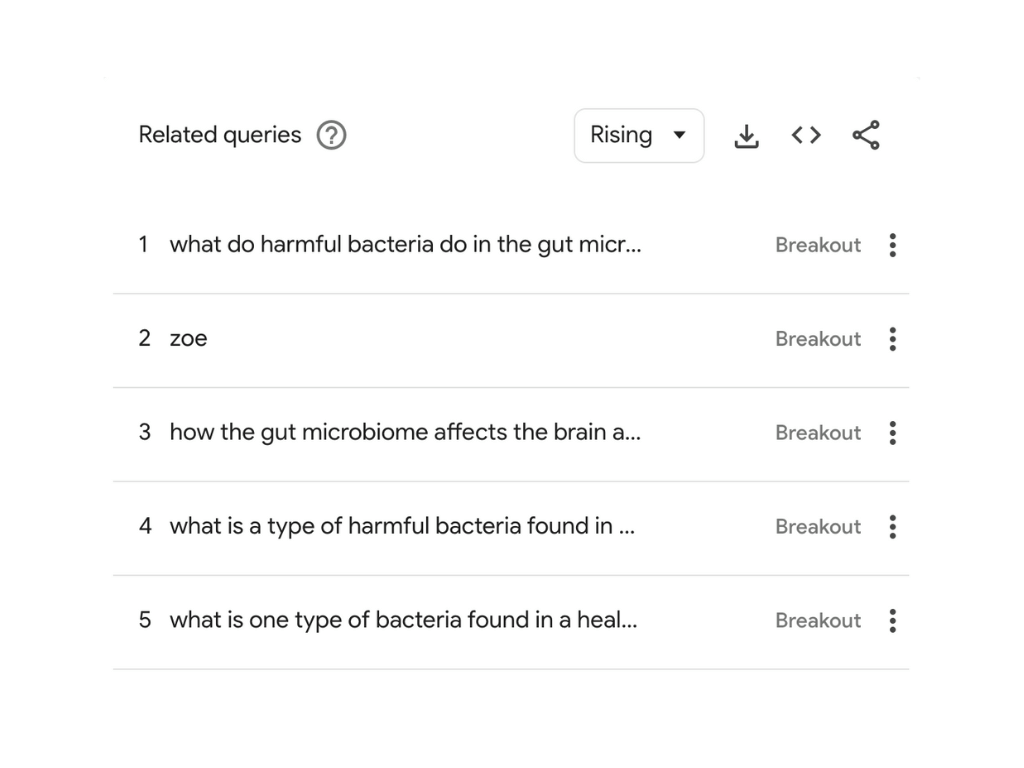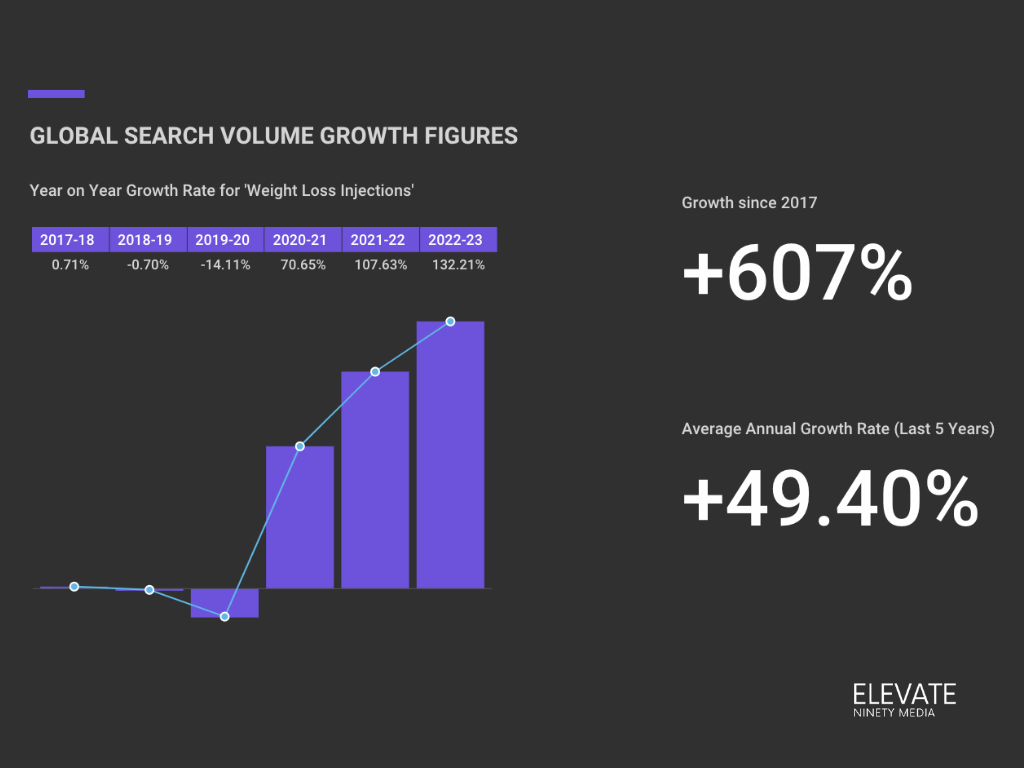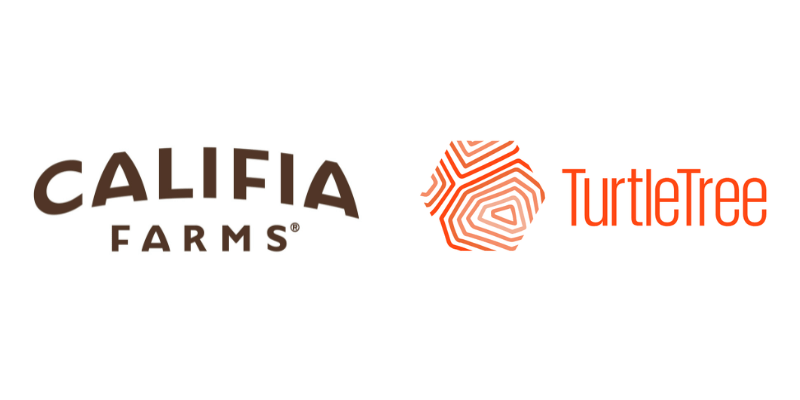Introduction to Google Trends: Understanding the Basics
Google Trends is an indispensable tool for gaining insights into public interest and search behaviour. In the health and wellness industry, it can reveal evolving consumer interests, emerging health trends, and much more. This data is vital for businesses looking to stay ahead in a rapidly changing industry.
The metric that google trends uses to measure each query is called search interest. It refers to the level of interest or frequency at which users search for specific terms or topics on Google. It’s a measure of how often a particular term is queried relative to the total search volume across various regions and languages over a certain period.
Search Interest Over Time Explained
Google defines search interest over time as:
“Numbers represent search interest relative to the highest point on the chart for the given region and time. A value of 100 is the peak popularity for the term. A value of 50 means that the term is half as popular. A score of 0 means that there was not enough data for this term.”
Google trends
Google Trends data is both sampled and normalised to provide a comprehensive and understandable view of search interest over time and across different regions. For more information and FAQ’s about Google trends search interest and data click this link
Setting Up Your Research: Keywords and Topics in Google Trends
Begin by identifying keywords relevant to your specific niche within the health and wellness sector. These might include terms like “keto diet,” “mental wellness,” “yoga for beginners,” or “natural supplements.” Input these keywords into Google Trends to see their search interest over time, both globally and in specific regions. You can also explore related queries to find associated trends you might not have initially considered.


Google Trends – related topics and queries for ‘yoga for beginner’
Analysing Industry Trends: Interpreting Data from Google Trends
In the health and wellness sector, interpreting Google Trends data requires a nuanced approach. For instance, a rising trend in searches for “gut microbiome” suggests a growing interest in improving ones gut health.

When analysing such trends, consider the broader societal and industry contexts—perhaps there’s a general increase in awareness about gut health, or maybe a new scientific study has highlighted the benefits of various gut health diets. Look at the data over different time frames to distinguish between fleeting fads and solid, long-term trends. Additionally, analyse related queries to understand the specifics of what people are seeking, such as “how the gut microbiome affects the brain and mind” or “what do harmful bacteria do in the gut microbiome”.

Comparing Data: How to Use Google Trends to Analyse Competitors
Google Trends can be used for competitive analysis in the health and wellness sector. By tracking the popularity of competitor brand names or their flagship products, you can gauge your market position and identify areas for strategic improvement or differentiation.
Compare the search trends for your brand with those of your competitors to gauge market interest. This comparison can reveal not only your relative popularity but also help identify gaps in the market.

Also, if a competitor’s product, such as a specific type of yoga mat or a dietary supplement, is gaining traction, investigate the reasons behind its popularity. Is it due to better marketing, a unique product feature, or emerging consumer preferences? Understanding these nuances can inform your product development and marketing strategies, allowing you to position your offerings more effectively.
Geographical Insights: Using Regional Data for Targeted Research
Regional data in Google Trends is particularly valuable for localised marketing strategies. If a certain health trend is gaining traction in a specific region, businesses can target their marketing efforts or even adjust their product offerings to cater to that region’s unique preferences.
Google Trends enables businesses to understand how consumer interests vary across different regions, countries, and even cities. Take a look at the example in the screenshot below. The states with darker blue shades represent greater interest in search for blood pressure. This is not only valuable for companies that sell blood pressure related services and products e.g. blood pressure monitors. But it is also useful to understand which states may have a greater need for searching blood pressure. The search data may represent which states either has higher prevalence of blood pressure or are more proactively interested in improving their heart health. Furthermore, correlating these findings with either epidemiological, public health or survey data could provide very interesting insights for marketers, researchers and public health decision makers.

Why Geographical Insights Matter
- Customised Marketing Strategies: Different regions often have varying health trends and preferences. For instance, urban areas might show a higher interest in the latest fitness trends like boutique fitness classes or wearable fitness technology, while rural areas might focus more on outdoor activities and natural supplements. Understanding these nuances allows for more targeted and resonant marketing campaigns.
- Product and Service Localisation: A health supplement popular in one region might not have the same appeal in another. Geographical data can guide businesses in customising their product lines and services to meet local demands. For example, in areas where there’s a high interest in weight management, a fitness centre might offer specialised weight loss programs.
- Identifying Untapped Markets: By analysing regional data, businesses can identify areas with unmet needs or less competition. A wellness brand might find that certain regions have a growing interest in mental wellness but lack adequate services, presenting an opportunity for expansion.
- Seasonal and Cultural Relevance: Health and wellness trends can be heavily influenced by cultural and seasonal factors. For instance, the popularity of certain diets or fitness routines may peak during specific times of the year or in certain cultural contexts. Understanding these patterns is crucial for timing campaigns and aligning offerings with cultural norms.
- Segmentation and Targeting: Use Google Trends to segment markets based on regional interest levels. This segmentation helps in crafting messages that resonate more deeply with each audience.
Real-Time Applications: Using Google Trends for Immediate Insights
Real-time data from Google Trends is invaluable for health and wellness businesses looking to respond quickly to emerging trends. For instance, if there’s a sudden spike in searches for “immune-boosting foods” during flu season, nutritionists and health food stores can immediately tailor their content and offerings to meet this demand. Similarly, wellness centres, for example can leverage real-time data to offer timely workshops or webinars on topics that are currently trending, ensuring they remain relevant and responsive to consumer needs.
Best Practices: Tips and Tricks for Efficient Use of Google Trends
For health and wellness professionals looking to make the most of Google Trends, here are some best practices:
- Use Specific and Broad Keywords: Combine broad terms like “fitness” with specific ones like “HIIT workouts” to get a comprehensive view of your industry.
- Analyse Contextually: Always interpret trends within the broader context of current events, seasonal changes, and industry developments.
- Compare Time Frames: Compare data across different time frames to understand both short-term fluctuations and long-term trends.
- Leverage Regional Insights: Use regional data to customise your offerings and marketing strategies to suit local preferences and needs.
- Integrate with Other Data: Combine insights from Google Trends with other data sources like social media analytics and customer feedback for a well-rounded understanding.
- Regular Monitoring: Regularly monitor trends to stay updated with the latest changes and adapt your strategies accordingly.
- Ethical Use of Data: Always consider the ethical implications of your findings, especially when it involves sensitive health information.
Limitations of Google Trends
Using Google Trends can offer valuable insights, but it’s important to be aware of its limitations. Here are some key limitations to consider:
- Relative, Not Absolute Data: Google Trends provides data on the relative popularity of search terms. The numbers represent search interest relative to the highest point on the chart for a given region and time. This means it doesn’t provide the exact number of searches or absolute search volumes.
- Contextual Ambiguity: Search terms can be ambiguous. For example, a term like “Apple” could refer to the fruit, the technology company, or something else entirely. Without context, it can be challenging to interpret what users were actually searching for.
- Lacks Demographic Details: Google Trends does not provide demographic information about the people making the queries, such as age, gender, or income level. This limits the ability to perform detailed audience analysis.
- No Sentiment Analysis: The tool does not provide insights into the sentiment behind a search query – whether the search intent was positive, negative, or neutral.
- Potential for Misinterpretation: Without proper context or additional data sources, there’s a risk of misinterpreting what the trends data actually means for a specific industry or query.
- Not a Predictive Tool: While it can provide insights into past and current trends, Google Trends is not inherently predictive. Future trend predictions based on this data should be approached with caution.
Elevate Trends Provides All the Insights You Need
In the fast-paced world of health, wellness, and fitness, staying ahead of market trends is crucial for business success. This is where Elevate Trends steps in, offering a comprehensive solution for analysing search trends and consumer behaviour. Our platform specialises in dissecting the vast and complex world of online search data, specifically tailored to the health, wellness, and fitness industry.
Elevate Trends Speeds Up Your Research
Elevate Trends is designed to save you time and effort on the heavy lifting involved in research and analysis. We understand that digging through search trends, interpreting consumer behaviour, and drawing actionable insights can be a daunting task. Our service simplifies this process by delivering concise, insightful, and actionable data that will supercharge your marketing strategies and fuel your business growth.

Never Miss A Hot Trend
Our platform keeps a pulse on all the hot trends in the industry. Whether it’s the latest fitness craze, a new wellness approach, or emerging health products, we ensure you’re always in the know. But we don’t just stop at identifying trends; we delve deeper. We analyse seasonal trends, helping you to anticipate and plan for seasonal shifts in consumer interest, ensuring your business stays relevant all year round. Our Trend Signals section jumps on any hot trend in search where we analyse why the trend is occurring and provide actionable insight for your business.

Analysis of Search Behaviour
More importantly, Elevate Trends goes beyond surface-level data. We dissect the sentiment and intent behind consumer search queries. Understanding why consumers are searching for specific health and wellness topics is just as important as knowing what they are searching for. This deep dive into consumer intent allows us to provide you with nuanced insights, enabling you to tailor your offerings and marketing messages more effectively to meet consumer needs and desires.


Our Elevate Trends search behaviour analysis and trend reports provide comprehensive analysis beyond search interest. We delve into actual search volume and provide contextual understanding for search sentiment and trends.
In summary, Elevate Trends is not just a tool—it’s your partner in navigating the complex landscape of consumer trends in the health, wellness, and fitness industry. With our insights, you can make informed decisions, stay ahead of the competition, and propel your business towards substantial growth. We go beyond the limitations of google trends to provide you with context, analysis and insights to gain a clearer picture of the latest trends and opportunities in the industry.
Why not sign-up for a free account today!





